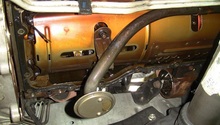Jeep Cherokee 1984-2001: Why is My Oil Pressure High?
Does your mechanical gauge read a very high PSI? This article will pinpoint some of the common reasons why that could be.
This article applies to the Jeep Cherokee XJ (1984-2001).
Oil pressure is important to the longevity of your motor's operation. Good oil pressure maintains steady combustion in a gas engine. When oil pressure is low, it is an indicator that the sensor is picking up less pressure than normal from the oil sending unit or oil pump. This could be due to insufficient oil amount in the oil pan or even blocked passageways. High oil pressure could be the result of a blocked oil filter or pump pickup. Using the right type of oil is also crucial to the correct operation of your motor at varying temperatures and speeds.

Materials Needed
- Mechanical oil pressure gauge
- Screwdriver
- Ratchet set with various sockets
- Drain pan
Step 1 – Check your oil pressure
It may be possible that the gauge inside your jeep is reading inaccurately.
- Connect a mechanical gauge to the oil filter adapter.
- Start the car and read for accurate pressure.

Figure 1. Oil filter adapter with pressure line threaded in. 
Figure 2. Mechanical pressure gauge reading oil pressure.
Pro Tip
At idle, the reading should not be less than 13 PSI. Under operation, the gauge should read between 30 to 60 PSI. You can also connect an aftermarket gauge and mount it to the dash.
Step 2 – Perform oil system cleaning
If your jeep has high mileage, its possible that the passageways to the pickup are blocked. A thorough cleaning can help the oil system read proper pressure.
- Drain two quarts of oil from the system.
- Fill the system up with Marvel Mystery Oil.
- Drive the jeep around to help move the fluid through the system.
- Perform oil change and replace with mostly brand new oil and another quart of Marvel Mystery Oil.
- Perform one more final oil change.
- Check the internal gauge and compare with readings on mechanical gauge for oil pressure.
Pro Tip
It's important that the system ends up with fresh oil and new filter when complete.
Step 3 – Replace oil pressure sensor
- Unscrew and remove existing sensor.
- Install new sensor securely and reconnect harness.
- Start the car to determine reading on internal gauge.
- Check for any leaks.

Pro Tip
Make sure to use sealant on the threads of the new sensor.
Featured Video: Replacing Oil Pressure Switch
Related Discussions
- Normal Oil Pressure Readings - CherokeeForum.com
- Diagnosing High Oil Pressure - CherokeeForum.com
- High Oil Pressure Discussion - CherokeeForum.com






